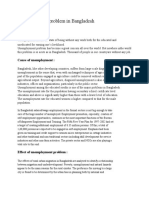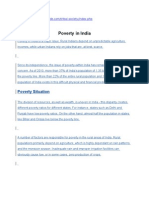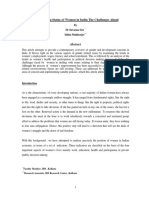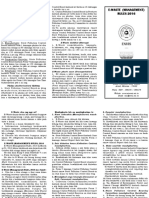0 ratings0% found this document useful (0 votes)
156 viewsFWPR in INDIA
FWPR in INDIA
Uploaded by
DaVid Silence KawlniThe document discusses trends in the female work participation rate (FWPR) in India based on Census of India data from 1971-2011. Some key points:
1) FWPR in India increased from 13.9% in 1971 to a peak of 31.6% in 2001 but declined to 25.6% by 2011, significantly lower than males.
2) Rural FWPR (24.8% in 2011) has consistently exceeded urban FWPR (14.7% in 2011) due to family/home-based work being more common in rural areas.
3) 92% of India's female workforce is in the unorganized/informal sector with low wages and lack of protections, compared to
Copyright:
© All Rights Reserved
Available Formats
Download as PPTX, PDF, TXT or read online from Scribd
FWPR in INDIA
FWPR in INDIA
Uploaded by
DaVid Silence Kawlni0 ratings0% found this document useful (0 votes)
156 views19 pagesThe document discusses trends in the female work participation rate (FWPR) in India based on Census of India data from 1971-2011. Some key points:
1) FWPR in India increased from 13.9% in 1971 to a peak of 31.6% in 2001 but declined to 25.6% by 2011, significantly lower than males.
2) Rural FWPR (24.8% in 2011) has consistently exceeded urban FWPR (14.7% in 2011) due to family/home-based work being more common in rural areas.
3) 92% of India's female workforce is in the unorganized/informal sector with low wages and lack of protections, compared to
Copyright
© © All Rights Reserved
Available Formats
PPTX, PDF, TXT or read online from Scribd
Share this document
Did you find this document useful?
Is this content inappropriate?
The document discusses trends in the female work participation rate (FWPR) in India based on Census of India data from 1971-2011. Some key points:
1) FWPR in India increased from 13.9% in 1971 to a peak of 31.6% in 2001 but declined to 25.6% by 2011, significantly lower than males.
2) Rural FWPR (24.8% in 2011) has consistently exceeded urban FWPR (14.7% in 2011) due to family/home-based work being more common in rural areas.
3) 92% of India's female workforce is in the unorganized/informal sector with low wages and lack of protections, compared to
Copyright:
© All Rights Reserved
Available Formats
Download as PPTX, PDF, TXT or read online from Scribd
Download as pptx, pdf, or txt
0 ratings0% found this document useful (0 votes)
156 views19 pagesFWPR in INDIA
FWPR in INDIA
Uploaded by
DaVid Silence KawlniThe document discusses trends in the female work participation rate (FWPR) in India based on Census of India data from 1971-2011. Some key points:
1) FWPR in India increased from 13.9% in 1971 to a peak of 31.6% in 2001 but declined to 25.6% by 2011, significantly lower than males.
2) Rural FWPR (24.8% in 2011) has consistently exceeded urban FWPR (14.7% in 2011) due to family/home-based work being more common in rural areas.
3) 92% of India's female workforce is in the unorganized/informal sector with low wages and lack of protections, compared to
Copyright:
© All Rights Reserved
Available Formats
Download as PPTX, PDF, TXT or read online from Scribd
Download as pptx, pdf, or txt
You are on page 1of 19
FEMALE WORK PARTICIPATION
RATE (FWPR) IN INDIA
• The Census of India has been customarily
collecting and presenting disaggregated data
for male and female population. The
composition of population by gender is one of
the primary demographic characteristics of
human population around which meaningful
analysis is women.
• A worker is defined as a person who
participates in any economically productive
activity, which could be either physical or
mental in nature. The work involves not only
actual work but also effective supervision and
direction of work.
FWPR IN INDIA (COI)
• 1971 : 13.9%
• 1981 : 19.8%
• 1991 : 22.5%
• 2001 : 31.6%
• 2011 : 25.6%
• The Female Work Participation Rate in India is
far behind that of males.
• The 1971 definition of workers included only
such persons in the category of workers
whose main activity was economically
productive work. As a result households and
students who also have been participating in
economic activity for minor part of their time
got excluded from definition of labour force.
This definitional change had affected the
workers in general but the effect was felt more
among the women than men.
• As regard the 1971 and 1981 censuses there
was a considerable concern about the
undercount of female workers. And hence
1991 census was redefined to include ‘unpaid
workers’. In spite of these changes FWPR
according to 1991 census showed only a
marginal increase.
RURAL-URBAN FWPR
• Years Urban Rural
1971 6.68 13.42
1981 8.31 23.06
1991 9.2 26.70
2001 3.24 23.29
2011 14.7 24.8
• This may be due to the difficulty in combining
work with other household and other urban
duties in urban areas. In contrast in rural areas
work on the family or in the family enterprises
constitute the main activity, leading to a rise in
WPR.
• Moreover, in rural areas unmarried girls,
young wives, busy mothers as well as older
women are being forced by difficult economic
situations to seek some kind of employment.
As a result FWPR in the rural areas is much
higher than the participation rate in the urban
areas.
FEMINISATION OF AGRICULTURE
• In recent years men have been increasingly
move to the urban sectors in search of job
opportunities, mainly due to low productive
manual work of cultivation in rural areas.
These jobs are left to be done by their
womenfolk leading to a rise in rural FWPR.
This is one of the crucial factors responsible
for feminization of agriculture.
• Post reform period has also witnessed
diversion of land from food crops to
cultivation on a much larger scale to non-food
crops like floriculture and horticulture, all of
which employ a growing number of female
workers. This trend may therefore be another
reason leading to a rise in FWPR in the rural
sector.
FWP IN THE ORGANISED SECTOR
• the proportion of female employment in the
organized sector is far below that of male
employment, which signifies that in spite of
growing literacy, employment of women in
the organized sector is still negligible.
• Regarding the recent increase in women’s
employment, the Employment Market
Information Programme, which collects
employment statistics for the organized
sectors, has revealed that though employment
for women has increased in the organized
sector but it was highest in what is possibly
the most backward and low paying segments
in organized industry.
FWP IN THE UNORGANISED SECTOR
• The unorganized sector mean the informal,
traditional and unregulated sector. This sector
employs a large proportion of working women
in India.
• According to an estimate of the National
Commission on Self-Employment of Women,
92% of the total female workforce operates in
the unorganized sector.
• Workers in the unorganized sector are
unprotected by law and they are the most
vulnerable sections of the society with low
bargaining power.
• Wages in this sector tend to be extremely low
leading to high levels of poverty that affects the
overall health of a woman, children in terms of
calorie intake, health care and education which is
reflected in low human development index.
• In successive census, concept of workers has
been changing and some do not have a
comparable data of women and their exact
contribution to economic work. There is an
exclusion of a whole range of activities
performed by women, the unpaid economic
activities, their economic contribution in work
through domestic sectors; their long hours of
household work remain unaccounted.
FWPR INDIA:WORLD
• India ranks the second lowest in the Group of
20 (G20) economies when it comes to
women’s participation in the workforce,
according to a report published by aid
group Oxfam . It is above only Saudi Arabia, a
country that does not allow its women to
drive.
• When it comes to women’s economic
participation, India’s position seems fixed at the
bottom even when we compare it to the entire
world and not just the 20 major economies. It
ranks 124 out of 136 nations, according to a
World Economic Forum (WEF) report from last
year.
• All the BRICS nations rank much higher than
India. The 12 countries below India include
countries riven by political instability, such as
Pakistan, Egypt and Syria.
• The country’s GDP can increase by more than
a quarter if it can match male and female
employment rates, according to a report by
consulting firm Booz & Co..
You might also like
- Oracle E-Business Suite R12.1 Human Capital Management PreSales Specialist AssessmentDocument16 pagesOracle E-Business Suite R12.1 Human Capital Management PreSales Specialist AssessmentQoba100% (1)
- Model Residential Construction Contract Cost Plus Version 910Document20 pagesModel Residential Construction Contract Cost Plus Version 910tpushkar9208No ratings yet
- Checklist Site InspectionDocument29 pagesChecklist Site Inspectionthanzawtun198191% (11)
- Women, Populations, Vulnerable SectionsDocument37 pagesWomen, Populations, Vulnerable SectionsNikhil PrasadNo ratings yet
- Work Force Participation in IndiaDocument16 pagesWork Force Participation in IndiaNidhi BansalNo ratings yet
- Vision IAS Mains 365 2019 Social Issues PDFDocument71 pagesVision IAS Mains 365 2019 Social Issues PDFVishnuvardhanreddy PalvaiNo ratings yet
- Translated Doc 1Document88 pagesTranslated Doc 1Om paraka kumar KumarNo ratings yet
- Umemployment in IndiaDocument14 pagesUmemployment in IndiaHeena ShaikhNo ratings yet
- employmentDocument16 pagesemploymentkkharshu218No ratings yet
- Session 8 InequalityDocument12 pagesSession 8 Inequalitykaushtubh_496909036No ratings yet
- Women Entrepreneurs in Bangladesh Challenges and Determining FactorsDocument14 pagesWomen Entrepreneurs in Bangladesh Challenges and Determining FactorsJubair NewazNo ratings yet
- Addressing Unpaid Domestic Work Done by WomenDocument3 pagesAddressing Unpaid Domestic Work Done by WomenparvezNo ratings yet
- Diversifying India's Rural EconomyDocument12 pagesDiversifying India's Rural EconomyAMAN KUMARNo ratings yet
- Women Participation in Informal Sector and Poverty Reduction in Bushenyi District Local Council of UgandaDocument6 pagesWomen Participation in Informal Sector and Poverty Reduction in Bushenyi District Local Council of UgandaKIU PUBLICATION AND EXTENSIONNo ratings yet
- Women Workers in India by Vibhuti PatelDocument13 pagesWomen Workers in India by Vibhuti PatelVibhuti PatelNo ratings yet
- Female Labour Force Participation in India NewDocument26 pagesFemale Labour Force Participation in India NewAnuj SahuNo ratings yet
- Gender Dimensions of Employment in IndiaDocument23 pagesGender Dimensions of Employment in IndiaADBGADNo ratings yet
- Advancing Womens Workforce Equality - Rishabh Popat PDFDocument3 pagesAdvancing Womens Workforce Equality - Rishabh Popat PDFRishabh PopatNo ratings yet
- Unemployment Problem in Bangladesh 1Document3 pagesUnemployment Problem in Bangladesh 1paul himel100% (1)
- Status of Women in PakistanDocument7 pagesStatus of Women in PakistanRab DinoNo ratings yet
- Gender Gap in AgricultureDocument35 pagesGender Gap in AgricultureRish MakchaNo ratings yet
- Women Work IndiaDocument4 pagesWomen Work Indiarahul mNo ratings yet
- Demographic Features: Work Force CompositionDocument3 pagesDemographic Features: Work Force CompositionAmit DungdungNo ratings yet
- MaceDocument5 pagesMaceraja sinhaNo ratings yet
- Privatisation, Economic Liberalization and Impacts On Women Workers in NepalDocument4 pagesPrivatisation, Economic Liberalization and Impacts On Women Workers in NepalIsmith PokhrelNo ratings yet
- India's Women and The WorkforceDocument4 pagesIndia's Women and The Workforcejagadevikas9393No ratings yet
- Unemployment and Unemployment in PakistanDocument63 pagesUnemployment and Unemployment in Pakistanstrongcrazysolid86% (7)
- Unit-21 Changing Occupational Structure and Impact of Economic LiberalizationDocument16 pagesUnit-21 Changing Occupational Structure and Impact of Economic LiberalizationMilani JithinNo ratings yet
- Gender BiasDocument20 pagesGender BiasRahul Wani50% (2)
- Gender and Poverty - 20.03.2024Document15 pagesGender and Poverty - 20.03.2024Gunjan ChoudharyNo ratings yet
- Employment and Inequality Outcomes in IndiaDocument43 pagesEmployment and Inequality Outcomes in IndiaEdiNo ratings yet
- Final ProjectDocument82 pagesFinal ProjectSaurabh KumarNo ratings yet
- Class Note ImportantDocument5 pagesClass Note Importantvidit vishnoiNo ratings yet
- ProjectewDocument10 pagesProjectewNazrul IslamNo ratings yet
- Women AND DEVELOPMENTDocument3 pagesWomen AND DEVELOPMENTnajaf abbasNo ratings yet
- Gec Elec3 - M2 01Document32 pagesGec Elec3 - M2 01Lagran, Micah AndreaNo ratings yet
- University of Central Punjab.: Bs-Commerce/ADPDocument10 pagesUniversity of Central Punjab.: Bs-Commerce/ADPWadOod KhAnNo ratings yet
- E: G, I I: Mployment Rowth Nformalisation AND Other SsuesDocument23 pagesE: G, I I: Mployment Rowth Nformalisation AND Other Ssuesvivek06vivekNo ratings yet
- Assignment: Submitted To: Submitted BYDocument11 pagesAssignment: Submitted To: Submitted BYafrinashrafNo ratings yet
- Concept of Unemployment in IndiaDocument33 pagesConcept of Unemployment in Indiapriyankakushwaha8463No ratings yet
- Women in Agriculture in KenyaDocument12 pagesWomen in Agriculture in KenyaVanshika SinghalNo ratings yet
- ImageDocument28 pagesImagekumarabhi58168No ratings yet
- Role of Women in Rural DevelopmentDocument8 pagesRole of Women in Rural DevelopmentAbdiaziz HassanNo ratings yet
- India - An OverviewDocument8 pagesIndia - An Overviewdeepkamal_jaiswalNo ratings yet
- Women S EmploymentDocument23 pagesWomen S EmploymentAnil Singh RajputNo ratings yet
- The Changing Status of Women in India-The Challenges Ahead: DR Suvarna Sen Ishita MukherjeeDocument21 pagesThe Changing Status of Women in India-The Challenges Ahead: DR Suvarna Sen Ishita MukherjeeShyamsunder SinghNo ratings yet
- DeepDocument67 pagesDeepsatya8789126142No ratings yet
- CH-7 EMPLOYMENT NOTES (2) (1)Document8 pagesCH-7 EMPLOYMENT NOTES (2) (1)niharikanalluri123No ratings yet
- Module 4 - IleDocument16 pagesModule 4 - Ilemrsynapse22No ratings yet
- Chapter 7Document23 pagesChapter 7vivajokkNo ratings yet
- Real or IllusionDocument5 pagesReal or IllusionVashistaNo ratings yet
- Unnamed2 - Insert WatermarkDocument39 pagesUnnamed2 - Insert WatermarkNikita JatNo ratings yet
- Broad Profile of The Indian Economy & MacroDocument59 pagesBroad Profile of The Indian Economy & Macroyashaswi_raj0% (1)
- From The Editor's Desk: Oikonomica: IDocument24 pagesFrom The Editor's Desk: Oikonomica: ISubhangi NandiNo ratings yet
- Chapter One1Document18 pagesChapter One1Ayogu ThomasNo ratings yet
- Economic Policy Paper On Women Entrepreneurs in Bangladesh: 1. BackgroundDocument31 pagesEconomic Policy Paper On Women Entrepreneurs in Bangladesh: 1. Backgroundshowrov212No ratings yet
- The Effects of Youth Unemployment and Its Implication On SocioDocument8 pagesThe Effects of Youth Unemployment and Its Implication On SocioUmungwor LuckyNo ratings yet
- Employment Creation For Youth in Africa The Gender Dimension PDFDocument26 pagesEmployment Creation For Youth in Africa The Gender Dimension PDFNadia ZrelliNo ratings yet
- UnemploymentDocument10 pagesUnemploymentZubair MalikNo ratings yet
- Urmi MukharjeeDocument13 pagesUrmi MukharjeeMahila Pratishtha JournalNo ratings yet
- Population Growth and Unemployment in India By Caste: Path Analysis: Unemployment by CasteFrom EverandPopulation Growth and Unemployment in India By Caste: Path Analysis: Unemployment by CasteNo ratings yet
- Fathers Work for Their Sons: Accumulation, Mobility, and Class Formation in an Extended Yoruba CommunityFrom EverandFathers Work for Their Sons: Accumulation, Mobility, and Class Formation in an Extended Yoruba CommunityNo ratings yet
- Operation and Maintenance Manual of Computer LabDocument4 pagesOperation and Maintenance Manual of Computer LabDaVid Silence Kawlni100% (1)
- Readers Writers Problem in Operating SystemDocument2 pagesReaders Writers Problem in Operating SystemDaVid Silence KawlniNo ratings yet
- UntitledDocument2 pagesUntitledDaVid Silence KawlniNo ratings yet
- Energy Science and EngineeringDocument181 pagesEnergy Science and EngineeringDaVid Silence KawlniNo ratings yet
- Page 1 of 39Document39 pagesPage 1 of 39DaVid Silence KawlniNo ratings yet
- Computer NetworkDocument20 pagesComputer NetworkDaVid Silence KawlniNo ratings yet
- E-Waste (Management) Rules 2016 - PamphletDocument2 pagesE-Waste (Management) Rules 2016 - PamphletDaVid Silence KawlniNo ratings yet
- E Governance: Lalhmingmawia Kawlni, Asst. Professor Govt. Serchhip CollegeDocument27 pagesE Governance: Lalhmingmawia Kawlni, Asst. Professor Govt. Serchhip CollegeDaVid Silence KawlniNo ratings yet
- Cyber Security: Awareness OnDocument19 pagesCyber Security: Awareness OnDaVid Silence KawlniNo ratings yet
- Web Programming With PHP: Bachelor of Computer ApplicationDocument24 pagesWeb Programming With PHP: Bachelor of Computer ApplicationDaVid Silence KawlniNo ratings yet
- Computer Fundamentals: David Kawlni, Department of Computer Science Govt. Serchhip College Coaching Centre 2022Document40 pagesComputer Fundamentals: David Kawlni, Department of Computer Science Govt. Serchhip College Coaching Centre 2022DaVid Silence KawlniNo ratings yet
- PAGEMAKERDocument5 pagesPAGEMAKERDaVid Silence Kawlni50% (2)
- Intro To ItDocument42 pagesIntro To ItDaVid Silence KawlniNo ratings yet
- Page MakerDocument7 pagesPage MakerDaVid Silence Kawlni0% (1)
- Gdi and GemDocument32 pagesGdi and GemDaVid Silence KawlniNo ratings yet
- V.DANISH - Domino's HRM ProjectDocument111 pagesV.DANISH - Domino's HRM Projectkamal arumugam731No ratings yet
- International Journal of Contemporary Hospitality ManagementDocument16 pagesInternational Journal of Contemporary Hospitality ManagementVishnu KPNo ratings yet
- Wa0015.Document19 pagesWa0015.sisodiyachetan30000No ratings yet
- 73165Document7 pages73165aarav100% (1)
- Experience, Appointment and Releiving LetterDocument3 pagesExperience, Appointment and Releiving LetterPema KotaNo ratings yet
- 198 English ParagraphsDocument16 pages198 English ParagraphselmauioNo ratings yet
- Chapter 10 - Global Human Resources ManagementDocument23 pagesChapter 10 - Global Human Resources ManagementHoàng Trần ĐứcNo ratings yet
- Caregiving - Course DesignDocument12 pagesCaregiving - Course DesigngilissaNo ratings yet
- Tragedy Essay - Death of A SalesmanDocument3 pagesTragedy Essay - Death of A SalesmanSeth GoodmanNo ratings yet
- BMGT 300-Organisational StructureDocument16 pagesBMGT 300-Organisational StructurePa HabbakukNo ratings yet
- NFPA 70E Sales SheetDocument2 pagesNFPA 70E Sales SheetCoinsesaNo ratings yet
- AIS Chapter 6Document14 pagesAIS Chapter 6Suen100% (2)
- Digital Orientation FInalDocument35 pagesDigital Orientation FInalNathalie ArhinNo ratings yet
- PAD 215 - Compensation and Benefits Enjoyed by Civil ServantsDocument21 pagesPAD 215 - Compensation and Benefits Enjoyed by Civil ServantsNORHANANI SHAIFNo ratings yet
- Wubalem Teshome - Jimma CampusDocument57 pagesWubalem Teshome - Jimma Campusetaferaw beyeneNo ratings yet
- Tracer StudyDocument3 pagesTracer StudyRichealyn C. TadeoNo ratings yet
- Performance Appraisal PolicyDocument3 pagesPerformance Appraisal PolicyAboli KhodweNo ratings yet
- Laptop Policy - HR (Final)Document3 pagesLaptop Policy - HR (Final)Padmaj RaneNo ratings yet
- Compensation FixationDocument25 pagesCompensation FixationAtiya RahmanNo ratings yet
- Semester IIIDocument12 pagesSemester IIIShankar CNo ratings yet
- Fortune Insurance Vs CA G.R. No. 115278 May 23, 1995Document2 pagesFortune Insurance Vs CA G.R. No. 115278 May 23, 1995Emrico CabahugNo ratings yet
- Tels Application PDFDocument4 pagesTels Application PDFalenaNo ratings yet
- Course of Lectures F.MDocument164 pagesCourse of Lectures F.MОлеся ДюгованецьNo ratings yet
- UPSC Civil Services Prelims ResultsDocument32 pagesUPSC Civil Services Prelims ResultsNDTVNo ratings yet
- The Guerilla Film Makers Handbook (UK) 3 Edition by Chris Jones and Genevieve JolliffeDocument5 pagesThe Guerilla Film Makers Handbook (UK) 3 Edition by Chris Jones and Genevieve JolliffeOzan AkayNo ratings yet
- SM Wal-Mart Group 3Document32 pagesSM Wal-Mart Group 3Kennedy Ng100% (2)
- Health and Safety in Port Operations: Code of Practice ForDocument24 pagesHealth and Safety in Port Operations: Code of Practice Forandresboy123No ratings yet








































































































